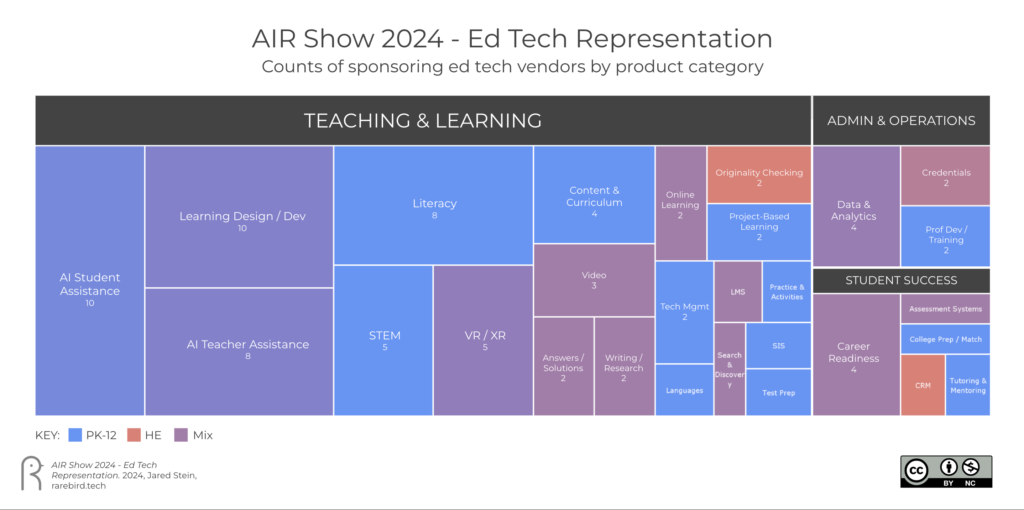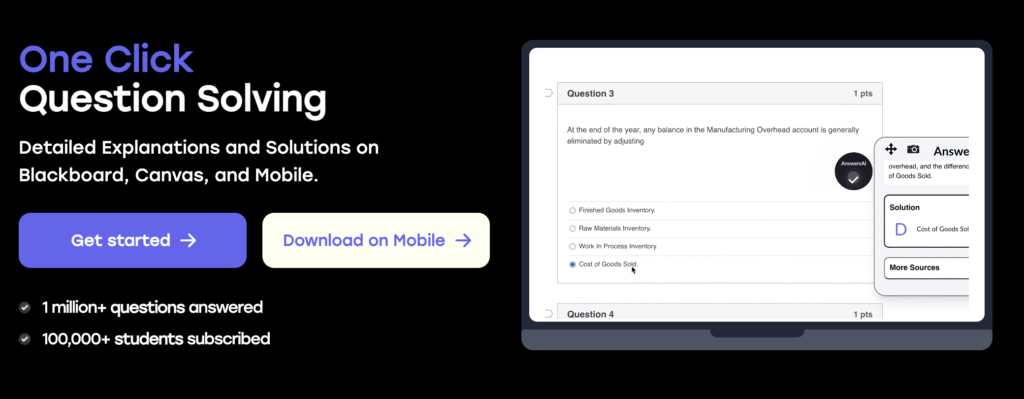Earlier this week, ASU+GSV hosted the inaugural AIR Show: AI Revolution just ahead of its own annual summit. Over 80 ed tech companies sponsored the AIR Show, and most showcased their new AI-based products or features during the event.
Touring the exhibit hall, I couldn’t help but see some patterns, so when I got back from ASU-GSV I set to categorizing all of the ed tech sponsors by product type and primary market served:

A few notes about this analysis:
- Box size represents number of ed techs
- Color represents target education market
- 1 category per ed tech (though some do transcend)
- Relative usage of AI is not represented; some ed techs are totally reliant on AI while others use AI to complement pre-existing products
- Excludes non-product companies as well as horizontal (not primarily edu) companies
You can download / share the original here: https://rarebird.tech/wp-content/uploads/2024/04/air-show-2024_rarebird.png
Over- and Under-Represented Ed Tech Categories
The vast majority (81.4%) of ed tech sponsors at the 2024 AIR Show are in the Teaching and Learning cluster — tools used primarily by teachers or students to facilitate learning.
Within that cluster, 25% are what I call AI Assistance tools for teachers or students. These are primarily based on generative AI and aim to help teachers and students in a variety of ways. For example…
- Providing information
- Synthesizing content
- Assisting in planning / scheduling
- Generating assessment prompts, items, rubrics, etc
- Assessing student work
- AI “Tutoring” or “coaching”
Etc. For example, Magic School AI, which appears to be a tool box of AI assistance prompts and interfaces for K-12 teachers.
Note that the AI Teaching Assistance category does not include AI tools specifically for learning content design or development. Tools that were directly focused on helping teachers plan lessons, design modules, or generate content felt quite distinct and appear as the Learning Design / Dev category.
Speaking of which, Learning Design / Dev tied for first with over nine ed techs represented at the AIR Show (>10% of the overall exhibitors). On the one hand, this should be no surprise, as generating content and organizing or synthesizing information is what the current wave of AI seems best at.
On the other hand, this is just one example of how noisy ed tech AI is right now, and how competitive it will be for ed techs — at least in the near-term.
Because the AIR Show’s sponsors leaned heavily toward K-12 markets, it’s no surprise that there were a lot of domain-specific tools for K-12, like literacy, STEM, and languages. Ed techs in these categories are primarily content-based, but because they often see specialized products or companies I break them out from the more general Digital Content & Curriculum category.
I was surprised that I saw only 2 ed techs in the Originality Checking (aka Academic Integrity) category: Turnitin and GPTZero. I get that policing students sucks, but figuring out academic integrity in the age of AI is critical for education (and society writ large). No matter what your personal opinions of these products are, their proposed solutions need to be part of the conversation .
Who Else Wasn’t There?
If you look at the list of AIR Show’s sponsors, there are many other notable absences from the roster. I know some of those ed techs did participate at the larger ASU+GSV Summit later in the week. But why weren’t they also at AIR Show?
Perhaps it was the added cost. Perhaps they had nothing (yet) to contribute to the AI conversation. Or perhaps they concluded that the business ROI for them would be low (read: lead gen).
Expanded / Alternate Product Categories
Most of the product categories here are ones that you may already be familiar with, and many have proven their value in education even before the rise of generative AI. However, coming out of ASU+GSV I have altered some of the product categories that I use in Rarebird’s consulting services and market maps:
- AI Teaching Assistance (expanded from “AI Grading”)
- AI Student Assistance (expanded from “AI Tutor”)
- Answers / Solutions (broken out from “Study Support”)
This last category includes products that are primarily focused on providing learners with immediate answers or solutions to questions. It is actually not entirely new. For example, it could include long-running online platforms like Chegg or CourseHero. Prior to the AIR Show I would have classified those as simply “Study Support”.
But as I looked at their products and their online marketing, I think it’s time to call a spade a spade.

Both of the products in this category aren’t shy about proclaiming their purpose: They derive the answers so you don’t have to.
And, as you can see in the screenshot above, this is clearly meant to be answers to assigned class work, including live answers during an online quiz or test.
Both products play some lip service to helping students “learn” or working with institutions, but I don’t take that seriously, since neither withholds answers until students work through a learning interaction.
Wrap-Up
I’ll admit it: The inaugural ASU+GSV AIR Show was fun.
I remain cautiously optimistic about the impact generative AI can have on education, though I do have concerns about how AI seems to be sucking the air out of the room in terms of both educators’ attention and investors’ interest. But AIR proved to be a good way to do a pulse check on what’s happening amongst AI-driven startups in ed tech.
Assuming AI doesn’t implode this year, I expect ASU+GSV to do this again in 2025, and I expect to attend.


One Reply to “Ed Techs @ the 2024 AIR Show Tilt Toward Teaching & Learning”
Comments are closed.